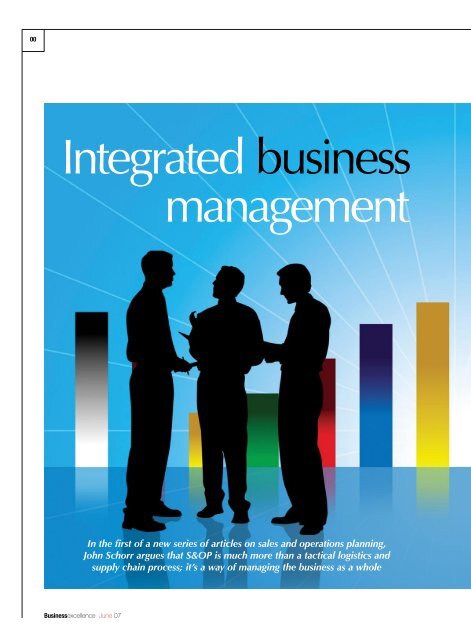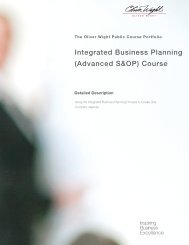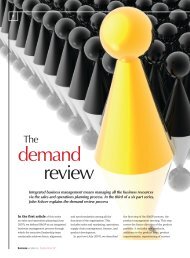Integrated business management - Oliver Wight Americas
Integrated business management - Oliver Wight Americas
Integrated business management - Oliver Wight Americas
- No tags were found...
Create successful ePaper yourself
Turn your PDF publications into a flip-book with our unique Google optimized e-Paper software.
00<strong>Integrated</strong> <strong>business</strong><strong>management</strong>In the first of a new series of articles on sales and operations planning,John Schorr argues that S&OP is much more than a tactical logistics andsupply chain process; it’s a way of managing the <strong>business</strong> as a wholeBusinessexcellence June 07
Strategic <strong>management</strong>00Over the years many companieshave moved from disconnected<strong>management</strong> processes, with alltheir informality and fire-fightingactivities, to having capable planningand control processes in place. Thismovement has allowed companiesto improve their customer service,improve their inventory <strong>management</strong>,improve direct labor productivity, andlower purchasing costs. Surveys haveshown dramatic results in companiesthat have achieved Class ‘A’ results.One of the keys to this improvementhas been sales and operationsplanning (S&OP).Sales and operations planning isan integrated <strong>business</strong> <strong>management</strong>process through which the executive/leadership team continually achievesfocus, alignment and synchronizationamong all the functions of theorganization. The monthly S&OP planbrings together all the plans for the<strong>business</strong> (customers, sales, marketingdevelopment, manufacturing,servicing, and financial) into anintegrated set of plans. These plansare reviewed by senior <strong>management</strong>at an aggregate (product family)level and the output of the processis a definitive statement of what thecompany plans to do for the next 18to 24 months.Unfortunately, many companiestoday that have an S&OP processare not getting all the benefits theyshould because they undervaluethe process and treat it as tacticalsupply and demand balancing only.They see it as a logistics and supplychain process to better manageinventory, production and thelogistics functions of the <strong>business</strong>. Infact, sales and operations planning ismuch more than that.S&OP is a strategic process thattalks about the gaps to the strategicplan, <strong>business</strong> plan, and performancemetrics and develops scenarios toJune 07 Businessexcellence
00Demand / Supply - All Products Total RevenueNext 12 Months $107,000,000Demonstrated Capacity - All Products© <strong>Oliver</strong> <strong>Wight</strong>© <strong>Oliver</strong> <strong>Wight</strong>fill those gaps. Let me give you anexample of the difference between atactical and a strategic S&OP process.I was asked a few years ago to visita company in Lincoln, Nebraska toassess its current S&OP process. Isat in on the demand review meetingand listened as the VP of sales laidout the demand plan for the next 12months. The projections showed asteady growth in revenue month aftermonth and the assumptions that weregiven backed up the growth. The VP ofRevenue Per MonthDemand / Supply - All Products Total RevenueNext 12 Months $107,000,000Revenue Per Monthsales concluded that revenue would hit$107 million for the year. After a gooddiscussion on the tactics and actionplans behind that projection, everyoneat the demand meeting agreed it was avalid demand plan.figure 1figure 2The supply meeting followed acouple of days later, and after muchdiscussion and review of alternatesupply scenarios, it was agreed thatonly one work center was short of therequired capacity to hit the demandplan. The addition of a $50,000piece of equipment would resolvethe problem and the money wasavailable to buy the equipment. As aresult, the supply plan was agreed.I then sat in on the finance meetingand after running a few financialscenarios, it was determined thatcosts were rising in a couple ofareas. A study had already beencompleted showing that by offshoringsome products, costs couldbe kept below budget. Everyoneagreed to recommend those productsbe produced in China. The S&OPpacket was assembled for the S&OPexecutive meeting, reflecting theaddition of a piece of equipment andthe move of a few products to China.Tactically, everyone was happy.Everyone attended the S&OPmeeting and reviewed their plansand assumptions. They all told thepresident of the company how theywere going to hit the $107 milliondemand plan and all agreed they hadthe <strong>business</strong> well under control. Theirsummary report looked like this:Recommendations:1. Add piece of equipment inmonth twelve.2. Off-shore the production ofproduct line A to reduce costs.The president looked at them allin amazement and said the S&OPplan was unacceptable. Everyone wasshocked; they had covered all theissues and had supply and demandin balance. The president identifiedthe problem. “I have committed to theboard of directors that we would hit$125 million in revenue this year andno one talked about how we will fillthe $18 million dollar gap (see figure2) between the <strong>business</strong> plan and thedemand plan.”Sales and operations planningis all about how to hit the strategicplan, the <strong>business</strong> plan, and theperformance metrics. The emphasisis on running the <strong>business</strong> as aBusinessexcellence June 07
Strategic <strong>management</strong>00<strong>Integrated</strong> Business Managment - S&OP© <strong>Oliver</strong> <strong>Wight</strong>figure 3whole, and not individual tactical ability to support the demand plan.plans. The diagram below illustrates This would include a review of thethe integrated <strong>business</strong> <strong>management</strong>, issues and options around thesales & operation planning process. materials, capacity, hedging, flexIt is a five step process.potential, improvement plans, andStep one is a product <strong>management</strong> seasonality patterns. Using rough cutreview. This step includes a complete capacity planning and demonstratedreview of the product portfolio and performance, the supply sideincludes new products, productdetermines if there are any issues withchanges, rationalization of products, producing the demand plan. Whereas well as any ‘new’ activities which there are issues, the supply sideinfluence demand, supply, or the develops alternative supply plans tofinancials of the <strong>business</strong>. These new resolve those issues. The outputs ofactivities can range from companywideinitiatives to process/technology and a proposed plan.this step are alternative supply planschanges. The output of this step is a Step four in the process is thenew activities plan which documents integrated reconciliation meeting.all the new products and newThis step takes the plans developedactivities and the resources needed to in the first three steps, pulls themimplement those plans.into an integrated <strong>business</strong> plan,Step two is a demand review. This develops a financial appraisal ofstep includes a complete review of those plans, identifies the gaps to thethe demand for all the company’s strategic plans, <strong>business</strong> plans, andproducts, both new and existing. performance metrics and recommendsThe output of this step is a timely, gap filling actions. The output of thisaggregate, unconstrained forecast with step is the S&OP packet that goesall the assumptions, action plans, to senior <strong>management</strong> at least 24opportunities, and vulnerabilities hours prior to the <strong>management</strong> reviewdocumented. This unconstrained meeting and is used to facilitate thedemand plan becomes the basis for the S&OP review.integrated set of planning numbers. Step five is the senior <strong>management</strong>Step three is a supply review.<strong>business</strong> review meeting. TheThis step evaluates the supply side’s inputs to this meeting are the keyperformance indicators, <strong>business</strong>trends, major changes to the planboth internal and external, keyissues to be reviewed and decisionsrequired by family, and the latestview of the alignment of the <strong>business</strong>with both the strategic plan andannual <strong>business</strong> plan. The outputof this meeting is agreement onan integrated set of numbers, arolling <strong>business</strong> planning appraisalof the next 18 to 24 months, andvalid performance measurements.If done correctly, the <strong>management</strong><strong>business</strong> review meeting is senior<strong>management</strong>’s handle on the<strong>business</strong> and gives them real<strong>management</strong> control over runningthe <strong>business</strong>.Over the next five months, Iwill review each of these steps(new product, demand, supply,integrated reconciliation, and the<strong>business</strong> review meeting) andwhat is required to make the salesand operations planning processsuccessful. Needless to say, if anyof these steps are deficient it willreduce the effectiveness of the<strong>management</strong> review meeting andsenior <strong>management</strong>’s ability to runthe <strong>business</strong>.John E. Schorr, a principal with<strong>Oliver</strong> <strong>Wight</strong>, has been with thecompany since 1979. For severalyears, he served as president of<strong>Oliver</strong> <strong>Wight</strong> International. He isrecognized as one of the leadingexperts in the areas of sales &operations planning (S&OP) andthe interface of purchasing withERP. Prior to joining <strong>Oliver</strong> <strong>Wight</strong>,John worked for two Class Acompanies and was involved inthe implementation of MRP II atboth: Haworth, where he was vicepresident of manufacturing, andSteelcase, one of the leading ClassA users of MRP II, where he wasdirector of purchasing.June 07 Businessexcellence
















